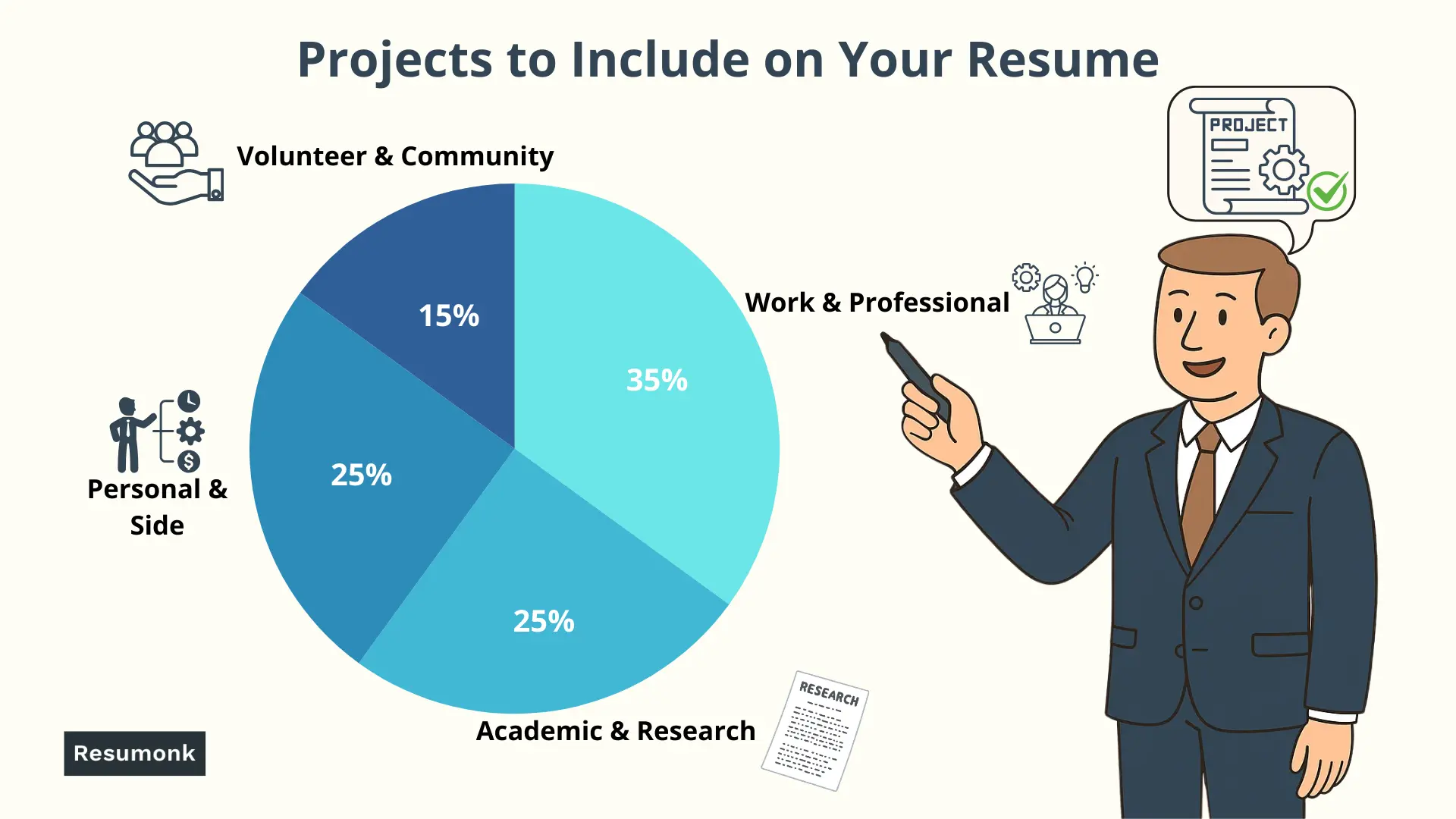
Most resumes read like they were written by the same person having a particularly boring day. Everyone "managed cross-functional teams" and "improved processes," but nobody actually tells the recruiter what they built or why it mattered.
The result is a stack of identical-looking candidates where the only differentiator is which design layout they used.
Projects are where you break free from this mediocrity trap.
They're the one place on your resume where you can show actual proof that you don't just talk about solving problems - you roll up your sleeves and solve them.
Whether it's the mobile app you coded in your spare time that now has thousands of users, the workflow redesign that saved your company six figures, or the research project that got published in a real journal, projects tell stories that job descriptions simply can't.
The challenge isn't finding projects to include - it's knowing which ones deserve precious resume real estate and how to write about them without sounding like you're reading from a corporate buzzword generator.
This guide walks you through the entire process: identifying which projects actually matter, placing them where recruiters will notice, and writing descriptions that turn "I did a thing" into "I solved this specific problem and here's exactly how much better things got afterward."
Picture your résumé as prime New York real estate: every square inch has to earn its keep.
Projects are the penthouse listings - limited, story-rich, and able to showcase views (a.k.a. results) ordinary job-duty bullet points can’t reach.
In résumé-speak, a “project” is a self-contained initiative with a clear start, finish and outcome - whether it was assigned by the boss, dreamed up in a dorm room, or coded after midnight.
Think problem → action → result, not “daily grind.”
Projects prove you can spot a knotty problem and untangle it without a babysitter.
Nearly 90% of employers rank problem-solving among their top sought-after résumé attributes ,and two-thirds now use skills-based hiring screens that prize demonstrable outcomes over pedigree.
Add in LinkedIn’s finding that “project management” sits at #4 on its 2024 Most In-Demand Skills list, and the case is clear: a tidy project vignette outmuscles a bland skill list every time.
Apply the Goldilocks test: include a project only if it is
(a) relevant to the target role,
(b) recent enough to matter, and
(c) results-oriented.
If it fails any one of those, let it nap in LinkedIn instead of eating résumé space.
.webp)
Not all projects wear the same jersey. Below is a scouting report on the four franchise players that consistently impress recruiters.
Cherry-pick assignments that stretched beyond your written job scope - new client implementations, cross-functional pilots or a process fix that saved real money.
Document your role, the team size and the business KPI you moved. Here's an example of how to do this:
SaaS Customer-Onboarding Revamp, Q3 2024 – Project Lead
- Automated welcome sequence and walkthrough videos; cut average time-to-value from 14 to 5 days and lifted NPS by 18 points.
For students, recent grads or career shifters, robust coursework and capstones can substitute for paid experience - especially if they mirror the target industry. Follow this simple format to display your projects in this scenario:
Thesis Title | Role | Date
Methodology | Equipment/ToolsKey Findings | Practical Application

Side gigs scream initiative.
Just make sure they’re finished, publicly viewable and relevant to the role. Here are some examples showcasing how:
Community initiatives prove leadership minus the paycheck. Highlight scope, stakeholders and social impact.
Example:
Neighborhood STEM Fair, Coordinator
- Recruited 30 volunteers
- Secured $8k in sponsorship and attracted 600 attendees; survey showed 92% felt “more confident” about STEM career paths.
Placement is half the magic trick: the same project can dazzle or disappear depending on where it sits.
Use the frameworks below (and let Resumonk’s beautifully designed layouts handle the heavy lifting).
If a project was performed on company time and ties directly to the job description, weave it under the matching role as a sub-bullet.
Software Engineer | Acme Corp
• Built REST API … (+ metrics)
• Key Project: Migrated legacy billing system; reduced queries by 65%
Use a standalone block (“Key Projects” or “Selected Projects”) when you have multiple spotlight-worthy wins across employers or freelance gigs
Academic research, labs and senior design work should ride shotgun with the degree that birthed them - especially for early-career candidates, as you can see in this example:
B.S. Mechanical Engineering | University of Melbourne (2025)
- Capstone: Solar-powered desalination prototype; achieved 12% higher efficiency than benchmark
Rule of thumb: put the juiciest, role-matching projects where a recruiter’s eyes land first.
Mid-career U.S. candidates often integrate under Experience, whereas U.K. résumés lean toward concise dedicated sections, and Australian recruiters appreciate a direct, results-first blurb.
Canadians split the difference with compact bullets plus a portfolio link.
The matrix above helps you weigh trade-offs.
Great projects die on résumés when they read like diary entries.
The fix is equal parts structure, storytelling, and cold-hard numbers - exactly what recruiters say separates high-impact bullets from background noise, as Harvard Business Review noted.
The Muse advises treating every project like a micro-case-study: give a title, timeframe, your role, a one-line problem statement, and the headline result.
When those five parts show up in the same order, recruiters process them in under eight seconds - about the time it takes to blink twice. Here's how to do this on your resume:
Supply-Chain Dashboard Revamp (Apr–Jun 2024) - Analyst(Context:) Excel-driven reporting took 4 hrs/week(Action:) Built Power BI dashboard integrating live ERP data(Outcome:) Cut report prep to 10 min, saving 190 hrs/year
Start each bullet with a vivid verb (“Spearheaded,” “Streamlined”) and reserve one line per outcome.
The Balance’s list of power words is a goldmine - pick verbs that match the skill you want to spotlight, then pair them with specifics.
.webp)
“More metrics and analytics you can add, the more impressive,” says former Amazon recruiter Lindsay Mustain.
Concrete numbers create instant credibility with hiring managers. Aim for at least one metric per project:
“Boosted organic traffic 42% in 90 days”“Reduced defect rate from 3.2% to 0.4%”“Saved $85K annually by renegotiating supplier terms”HBR notes that a modern résumé “speaks to the quantitative impact you’ve had at work,” but only if it mirrors the job ad’s language. In other words: remix the same project for different audiences.
Australian job board SEEK recommends weaving in the exact keywords recruiters screen for - just don’t force-fit jargon.
Here's a great example of how to tailor project descriptions for specific roles:Project Manager Targeting: Led a 6-member SCRUM team delivering MVP two sprints early, raising CSAT to 4.8/5.Data-Analyst Targeting: Modeled backlog cycle-time data, cutting sprint variance by 28% and lifting CSAT to 4.8/5.
Below are ready-to-copy templates that show how to frame results, tools, and scale - swap specifics to fit your story.
Tech hiring managers crave context (stack, methodology) followed by impact metrics. This set of examples illustrates this point accurately:
Campaign stories land when they include channel, audience, and ROI. Here are some stellar examples of how to display marketing and business projects on your resume:
Design isn’t “pretty pictures.” Tie the visuals to tangible outcomes. Here's how:
For research roles, cite method, sample size, and application. (CSUSB Research Guide echoes this too)
Whether you’re fresh out of college or steering a global division, your project stories should flex with context - and, yes, Resumonk’s AI builder can auto-tune length and tone for each scenario.
Campus career studies show that students who document capstones early land full-time roles faster.
Pair academic projects with class size, tools used, and the “so what” result, then keep bullets concise:
Capstone: Predictive Stock Screener
- Deployed Random Forest model (93% F1) forecasting S&P sector gains; presented to 120-student symposium.
Forbes coaches advise mid-career pros to foreground leadership KPIs - budget managed, headcount led, revenue grown - and demote routine deliverables to save space.
Translate projects into strategic wins:
“Scaled product line to three regions, adding $8M ARR.”
Try reframing prior projects around transferable competencies - think stakeholder management, data literacy, or process redesign - to bridge industries.
A quick label like “Industry-agnostic skill:” before each bullet helps recruiters connect the dots.
Preferences shift by postcode:
Use the matrix as your go-to compass to navigate this regional consideration labyrinth:
Think of a résumé as a spacecraft re-entering Earth’s atmosphere: even a tiny missing rivet (hello, typo) can cause a fiery disintegration during the six-second recruiter scan.
Studies continue to show that small errors - spelling, vague bullets, poor layout - knock otherwise great candidates out of contention.
The good news? Every blunder here is 100% preventable with a simple layer of proofreading.
Here are some errors you should look out for:
Top résumé coaches warn that irrelevant projects are the silent space-invaders of job applications - they steal word-count without adding lift.
Recruiters would rather see two laser-aligned wins than eight random side quests (we're sharing a few examples of what not to do below):
Forbes calls cluttered layouts and inconsistent fonts “the résumé equivalent of Comic Sans on a gravestone.”
Meanwhile, Monster’s 2025 survey lists bad spacing and misaligned bullets among the top ten deal-breakers.
The case is clear, correct formatting plays a subtle but significant role in the effectiveness of your resume:
❌ Before:
Key Projects: Redesigned CRM, Improved sales, Helped with docs
CRM Overhaul (Jan–Apr 2024) - Project Lead
• Migrated 22K records to HubSpot; reduced manual data entry by 70%
Notice how the “after” version adds hierarchy, dates, and metrics.
Your resume's project section isn't just a nice-to-have - it's where you prove you can spot problems and solve them without hand-holding. Here's your cheat sheet for turning scattered accomplishments into a career-launching project showcase:
Ready to transform your resume from a boring list of duties into a compelling story of results?
Resumonk's AI-powered builder helps you draft your resume with beautiful designs and AI recommendations.
Try it now and watch recruiter responses soar!